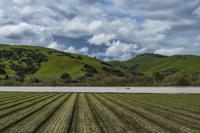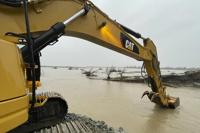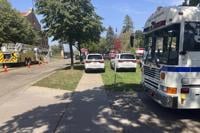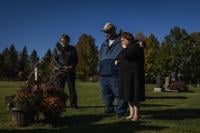WATSONVILLE, Calif. (AP) — The latest powerful atmospheric river to drench California put nearly 27,000 people under evacuation orders Tuesday due to flooding and landslide risks. On the central coast, workers hauled truckloads of rocks to plug a broken river levee amid steady rain and wind.
Damaging winds with gusts topping 70 mph (113 kph) blew out windows, and there were numerous reports of falling trees. Power outages hit more than 330,000 utility customers in northern and central areas, according to , which tracks outages nationwide.
Crews raced to stabilize the ruptured levee Tuesday, placing rocks and boulders to finish filling the gap that opened late Friday, about 70 miles (110 kilometers) south of San Francisco. Workers will then raise that portion's elevation to match the rest of the levee over the next few weeks to make it impermeable, officials said.
Tuesday's storm initially spread light to moderate rain over the state's north and center. But the ������ϲʹ������� Weather Service said the storm was moving faster than expected and that most of the precipitation would shift southward.
“Even a small amount of rain could potentially have larger impacts,” Shaunna Murray of the Monterey County Water Resources Agency said Tuesday during a news conference.
Powerful winds damaged windows in a San Francisco high-rise, causing glass to rain down and forcing evacuations from the building in the financial district. No injuries were immediately reported. A gust of 74 mph (119 kph) was recorded at the city's airport, the weather service said.
So far this winter, California has been battered by 10 previous atmospheric rivers — long plumes of moisture from the Pacific Ocean — as well as powerful storms fueled by arctic air that produced blizzard conditions. On the East Coast, with heavy, wet snow caused a plane to slide off a runway and led to hundreds of school closings, canceled flights and thousands of power outages Tuesday.
Along the Southern California coast, evacuation orders began at 8 a.m. in Santa Barbara County for several areas burned by wildfires in recent years, creating increased risk of flash floods and debris flows.
The storm caused emergency declarations for 40 counties.
In addition to evacuation orders, more than 71,600 people were under evacuation warnings and 546 people were in shelters by Tuesday morning, said Brian Ferguson, spokesperson for the California Office of Emergency Services. Updated figures were not immediately available.
More flooding was expected on the central coast, where the Pajaro River swelled with runoff from last week's atmospheric river. Authorities had not received reports of any deaths or missing persons related to the storm as of Monday.
The levee breach grew to at least 400 feet (120 meters) since the failure late Friday, officials said. A roughly 20-foot (6.10-meter) gap remained Tuesday afternoon.
Pajaro, an unincorporated community known for its strawberry crops, was largely flooded. More than 8,500 people were told to evacuate, and nearly 250 people have been rescued by first responders since Friday.
Some residents of the largely Latino farmworker community stayed. One shelter was already full by midday Tuesday, and officials were forced to open two more to accommodate the evacuees.
“We live seven houses away from the river and the water level was six feet high, seven probably,” said evacuee Andres Garcia. “So we probably lost everything.”
A second 100-foot (30-meter) breach in the levee opened closer to the Pacific coast, providing a “relief valve” for floodwaters to recede near the mouth of the river, officials said at a news conference Monday.
Built in the late 1940s to provide flood protection, the levee was a known risk for decades and had several breaches in the 1990s. Emergency repairs to a section of the berm were undertaken in January. A $400 million rebuild is set to begin in the next few years.
“We had so many years of drought and they could’ve fixed the levee way back and they didn’t," said Garcia, the Pajaro evacuee. "This is the second time it happened. Back in 1995, same thing. We lost everything.”
The river separates Santa Cruz and Monterey counties. Highway 1, a main link between the two counties, was closed along with several other roads.
___
Antczak reported from Los Angeles. AP writers Stefanie Dazio and Christopher Weber contributed from Los Angeles.


















































